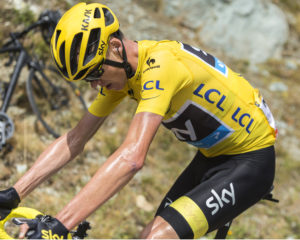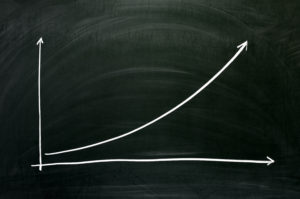What would happen if your life science marketing was just 1% better?
By David Chapin
SUMMARY
VOLUME 10
, NUMER 2
Life science marketing is a lot like cycling. Great Britain has dominated professional cycling over the last decade. The British team has won the Tour de France—cycling’s most prestigious event—5 out of the last 6 years. This record is amazing. To find its equal, you have to go back many years, to the time when […]
Life science marketing is a lot like cycling.
Great Britain has dominated professional cycling over the last decade. The British team has won the Tour de France—cycling’s most prestigious event—5 out of the last 6 years.
This record is amazing. To find its equal, you have to go back many years, to the time when Lance Armstrong won consecutive tours from 1998 to 2005—using performance-enhancing drugs. Given the consistently negative blood-test results, Lance’s record-shattering performance was often attributed to his incredible physique, as in, “Lance is an aberration, he’s one-of-a-kind.”
Fortunately, the current streak by the British cycling team springs from something that has nothing to do with performance enhancing drugs or a flawed testing protocol. Which is why I believe you can learn something from the British cycling team; something that can improve your life science marketing efforts.
You see, athletics and marketing share a common trait.

Chris Froome of the British cycling team, Team Sky. Believe it or not, athletics and life science marketing share a common trait.
Athletics and marketing.
Athletics and marketing are both multi-faceted. To be an outstanding athlete, you can’t focus on any one thing, you’ve got to focus on many things: nutrition, strength, agility, resiliency, sleep and psychology, just to name a few factors that can contribute to—or detract from—peak performance. There is synergy between all of these factors.
Marketing is similarly multi-faceted. Successful marketing teams have to pay attention to many factors, with synergy between them:
- technology (CRM, marketing automation, html, SEO, PPC: all you which you can learn more from the roofing digital marketing homepage)
- content (webinars, whitepapers, video, info graphics, etc.)
- social media (Linkedin, Facebook, Twitter, etc), sales (presentations, trade shows)
- PR (articles, journalists, mentions, press releases, etc)
- messaging (name, tag lines, headlines, body copy)
- positioning, products, sales support, pricing…
The list goes on and on.
I’m challenging you to elevate your (marketing) results to the level of Great Britain’s cycling team. While that may seem daunting, or an analogy too far, this is actually where things gets interesting. Because the same technique that got them to the yellow jersey can work for you.
Sir Dave Brailsford’s simple idea.
Great Britain’s cycling success can be traced to the arrival of Sir Dave Brailsford as the head of the country’s cycling efforts in 2003. Sir Dave is a former professional cyclist with an MBA. He brought with him a very simple technique to drive improvement throughout the organization. It’s known as the “aggregation of marginal gains.”
As he put it, “The whole principle came from the idea that if you broke down everything you could think of that goes into riding a bike, and then improved it by 1%, you will get a significant increase when you put them all together.”
Students of management theory will recognize this idea as an application of Kaizen, the theory of continuous improvement. Sir Dave took the Kaizen philosophy and encapsulated it into a simple question: “how can we get 1% better?”
Sir Dave explained his approach more fully in the Harvard Business Review:
“To give you a bit of background, when we first started out, the top of the Olympic podium seemed like a very long way away. Aiming for gold was too daunting. As an MBA, I had become fascinated with Kaizen and other process-improvement techniques. It struck me that we should think small, not big, and adopt a philosophy of continuous improvement through the aggregation of marginal gains. Forget about perfection; focus on progression, and compound the improvements.
By experimenting in a wind tunnel, we searched for small improvements to aerodynamics. By analyzing the mechanics area in the team truck, we discovered that dust was accumulating on the floor, undermining bike maintenance. So we painted the floor white, in order to spot any impurities.”
Sir Dave spread this philosophy throughout the team. They examined everything they could think of that might affect performance. One example? Sleep. A good night’s rest is critical for peak athletic performance the next day, particularly during the Tour de France, when cyclists cover 3500 kilometers in 21 stages over the course of 23 days. But athletes spend every night in a different hotel, and this makes getting consistent, high-quality rest difficult.
So Brailsford asked a simple question: how can we be 1% better in the way we give our racers the best sleep possible? He started by identifying the pillow that provided the best sleep. He then made sure that every athlete slept on their own individual pillow every night. That was a 1% improvement over sleeping on a different pillow every night.
But he didn’t stop there. Brailsford’s genius was to reapply the question. He asked, “Okay, now that every athlete is sleeping on his own personal pillow, how can we improve this by 1%?” And he asked that question again, and again, and again, and again.
The current effort? Great Brian’s cycling support team arrives at each hotel well before the athletes show up. They move all the existing hotel bedding out of the room, including the mattress, box spring, bed frame, sheets, towels, soap, everything. Then they give each room a thorough cleaning, and bring in each athlete’s own mattress and bedding. And the next morning, they replace all the hotel bedding, and move on to the next hotel.
Sir Dave applied this philosophy to every aspect of performance. Seat position, aerodynamics, nutrition, equipment, endurance training, the list goes on and on. For example, his team realized that keeping athletes healthy was crucial. As anyone who works in healthcare understands, washing your hands is one of the most powerful prophylactic measures available. So Sir Dave hired surgeons to teach riders how to wash their hands properly. And during the Olympics, they avoided shaking hands completely.
The results are amazing. Great Britain won an astounding 38 medals in the last three Olympic Games.
Applying Kaizen to your life science marketing efforts.
Let’s apply Sir Dave’s question to your life science marketing efforts. How could you make your marketing 1% better? It shouldn’t be too hard to think of several ways to get 1% better, right?
Take trade shows, for example. Whether your organization counts trade shows as a sales or marketing expense, attending them is expensive, and exhibiting often sucks up a significant portion of the budget. Given the expense, getting 1% better results would clearly be worth it.
How can you get 1% better at your trade show efforts? Let’s take a simple—and crucial—aspect of trade shows: follow-up with prospects. How quickly did you and your team follow up on leads received from the most recent show you attended?
The available statistics vary, but the trend is clear: most organizations don’t follow up very well. One study found that 80% of companies never followed up at all. And those that did were slow, often taking weeks to respond.
This delay severely hampers the value of any leads collected. You see, if your competitors are just a little bit faster in responding to leads, they’ve got an advantage. So how could you get just 1% better at the speed of follow up?
Could you have a campaign already programmed into your marketing automation program before the show even started? That would be 1% better, right?
Don’t use marketing automation? Then could you have the follow-up emails already written, with blank spaces for the customization that will make the follow-up feel more personal? That would be 1% better, right?
Having trouble getting your exhibit staff to enter the leads into your CRM? How could you get 1% better? Could you provide beer in the booth for the exhibit staff after the show floor closes every night, giving them time to enter the leads? Most salespeople could get their leads entered in the time it takes to drink one beer. This wouldn’t take long; they could still go to have drinks and dinner with clients. “Beer in the booth” might even improve the feeling of camaraderie among the team members. That’s one way to get 1% better. I’m sure you can think of many others.
The best part? Continuous improvement will yield results that compound with time.
Doubling your performance.
It’s hard to imagine doubling your performance, but it’s pretty easy to conceive of a 1% improvement. Back to cycling: it’s daunting trying to imagine a support team replacing all the bedding in every athlete’s hotel room every night. In fact, just thinking about it would probably lead to rejection of the idea. “Oh, that would be impossible. Think of all the logistics that would be required.”
But if you break this audacious goal down into a set of simple, 1% steps, it’s not so difficult to imagine. “Hey, we could find the best pillow, and give every athlete their own pillow every night.” And then, “You know, we could bring in our own towels.” And then, “And while we’re there, we should clean the room; we don’t want our athletes to pick up any germs.” And so on, and so on.
It’s easy to get better by 1%, if you and your team have the right attitude. And if you get 1% better every week, you’ll double your performance in about 72 weeks. That’s less than a year and a half. Some life science organizations attend more that 72 shows in a year. If they improved by 1% with every show, they’d double their performance in a year.
Achieving that kind of performance improvement in one jump is really difficult. But if you break it down into 1% increments, it’s easier to think about—and easier to make happen. That’s the beauty of the 1% philosophy.
To go big, think small (and then make a list).
There are two secrets to this method. The first is to involve your entire team. As Sir Dave said in his HBR interview:
“One caveat is that the whole marginal gains approach doesn’t work if only half the team buy in. In that case, the search for small improvements will cause resentment. If everyone is committed, in my experience it removes the fear of being singled out — there’s mutual accountability, which is the basis of great teamwork.“
The second is to keep your sights low, focused on factors that will be easy to achieve and will make a difference. A 1% improvement isn’t that much, but to realize the gains, you actually have to measure your performance and then take action, so now it’s time for you to build a list. Go ahead, grab a pen—I’ll wait.
What area of marketing needs the most improvement inside your organization? Think about this for a moment. Write down a few ideas.
Or consider what area of marketing would give you the most impact, if you were able to improve it just a little bit. Write those down.
Now, for each, write down what you’d measure to determine whether you’re improving—or not. Your metrics must be directly connected to the changes you’re going to implement. For example, you can’t measure the success of your SEO program by measuring the total increase in company revenue—the cause-and-effect connection between the two is too tenuous. Your metrics must be simple and easy to determine. To continue the SEO example, measuring how you rank for your top ten keywords would be very easy to accomplish, and would give you a clear view of whether you’re improving, even by 1%.
Keep your sights low
The goal of your Kaizen effort shouldn’t be to change the entire organization dramatically and suddenly. You shouldn’t need a drastic increase in budget or headcount. You just want to get a little bit better—just 1%.
Two things make this approach powerful. First, the effort required to get 1% better isn’t that significant. Second, if you improve everything you can think of by 1%, you’ll compound your gains.
How can you get 1% better?
Rinse, wash, repeat. Measure, improve, measure.
Once you’ve gotten 1% better, follow Sir Dave’s lead and ask the question again. Now that you’re 1% better, how can your team get 1% better than that?
And again. How can you get 1% better than that?
You’ve got no excuse. Next week, or for your next trade show, or the next time you publish content, or the next time you run a drip campaign, what’s stopping you from getting 1% better?
The Marketing of Science is published by Forma Life Science Marketing approximately ten times per year. To subscribe to this free publication, email us at info@formalifesciencemarketing.com.
David Chapin is author of the book “The Marketing of Science: Making the Complex Compelling,” available now from Rockbench Press and on Amazon. He was named Best Consultant in the inaugural 2013 BDO Triangle Life Science Awards. David serves on the board of NCBio.
David has a Bachelor’s degree in Physics from Swarthmore College and a Master’s degree in Design from NC State University. He is the named inventor on more than forty patents in the US and abroad. His work has been recognized by AIGA, and featured in publications such as the Harvard Business Review, ID magazine, Print magazine, Design News magazine and Medical Marketing and Media. David has authored articles published by Life Science Leader, Impact, and PharmaExec magazines and MedAd News. He has taught at the Kenan-Flagler Business School at UNC-Chapel Hill and at the College of Design at NC State University. He has lectured and presented to numerous groups about various topics in marketing.
Forma Life Science Marketing is a leading marketing firm for life science, companies. Forma works with life science organizations to increase marketing effectiveness and drive revenue, differentiate organizations, focus their messages and align their employee teams. Forma distills and communicates complex messages into compelling communications; we make the complex compelling.
© 2024 Forma Life Science Marketing, Inc. All rights reserved. No part of this document may be reproduced or transmitted without obtaining written permission from Forma Life Science Marketing.



